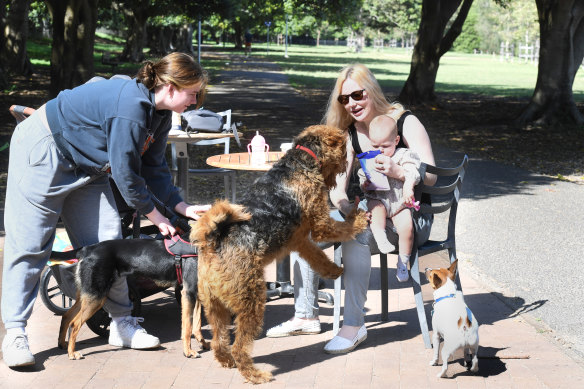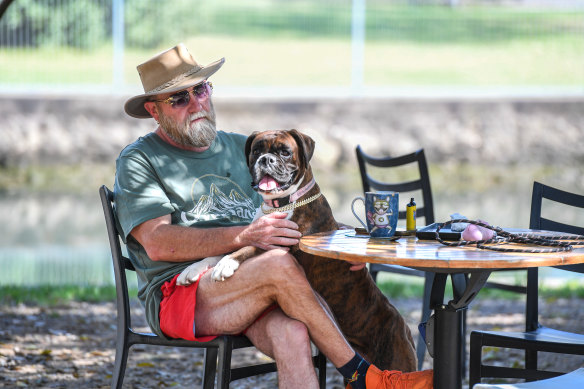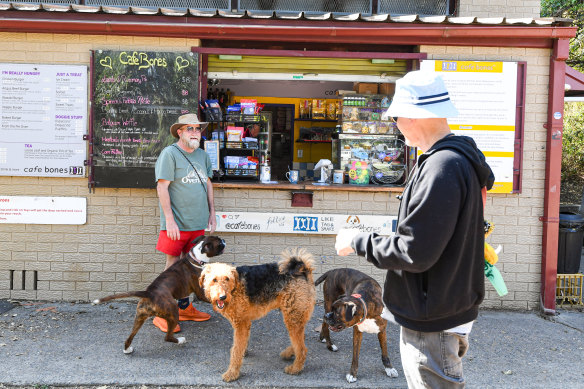By Matt Wade and Nigel Gladstone
Almost half of Sydney’s council areas have more dogs than children as the city’s canine population settles at a much higher level following a post-pandemic pet ownership boom.
There has been a 14 per cent increase in companion animal registrations on average since 2019-20 in NSW, Office of Local Government figures show. In a third of councils pet numbers rose by over 20 per cent between 2019 and 2023, according to companion animal microchip data.

Dog owner Rachel Fulcher and daughter Isabella with their dog Freddie and friends at Hawthorne Canal Reserve in Leichhardt.Credit: Peter Rae
In the City of Sydney council there’s just over two dogs for every child aged under 15, analysis by the Herald reveals. In Woollahra and Inner West council areas there are around 1.7 dogs for every kid. Inner West also has Sydney’s highest canine concentration of 1295 dogs per square kilometre.
Among Greater Sydney’s 34 local council areas, 16 have more dogs than children aged under 15 years.
Most days dog owner Rachel Fulcher brings her one-year-old daughter Isabella and the family’s Airedale, Freddie, to Cafe Bones at Hawthorne Canal Reserve, a popular inner west off-leash area.
She’s noticed more dogs at the park, “especially oodles” – referring to dogs that are a cross between poodles and other pure breeds.
“There’s a great mixture of dogs here, big and small, for Freddie to play with,” says Fulcher.
A recent national pet survey by industry group, Animal Medicines Australia (AMA), said a boom in pet ownership during the pandemic had “levelled-out to a ‘new normal’ of strong pet ownership”.
It found 48 per cent of households owned at least one dog in 2022, up from 40 per cent in 2019, while nearly two in five dogs had been acquired since the pandemic. NSW had 2.02 million dogs and 1.58 million cats in 2022, according to the survey.

Peter Conway and his dog Trixie are regular visitors to the off-leash area at Hawthorne Canal Reserve, LeichhardtCredit: Peter Rae
Dr Katie Asplin, the AMA’s director of animal health policy and engagement said there are important social benefits from pet ownership.
“There’s a lot of evidence that pets are good for your mental health, and they’re good for your physical health,” she said. “So I hope councils are looking for ways to make it easier for people to own pets.”
The metropolitan area’s most populated council area, Blacktown, also has the highest canine numbers, with 64,769 dogs (around 0.7 dogs per child under 15). Wollondilly council on Sydney’s south-west fringe had more than three dogs per child, the city’s highest ratio.
Demographer Mark McCrindle said one reason dogs outnumber children across much of Sydney is a steady decline in the birth rate; in 2023 there were nearly 10,000 fewer births in the city than in 2018. Last year Sydney’s fertility rate – the expected number of births per woman – hit a historic low of 1.57.
“We’ve seen big changes in household structures as dogs have become more and more popular,” McCrindle said.
The canine population figures also highlight how patterns of dog ownership have shifted.
“Traditionally, dogs were a suburban thing in the big backyard,” said McCrindle. “But that’s all changed … dog ownership is now very much in keeping with inner suburban lifestyles.”
There were more dogs than cats in every Sydney council area, although numbers were fairly similar in the City of Sydney (1.2 dogs per cat), Georges River (1.2), Inner West (1.3), Ryde (1.4) and North Sydney (1.5).
Cats outnumber children in the City of Sydney and the Inner West, while in Woollahra felines sit almost on purr with kids, at 1.1 cats per kid. Liverpool and Cumberland have the lowest ratio of cats to children, where little people outnumber them by almost eight and six to one, respectively.
Inner West had 36,400 cats, more than any other Sydney council.
The Herald’s comparisons used dog and cat numbers provided by Sydney councils or pet registration numbers collated by the Office for Local Government, as well as Bureau of Statistics regional population estimates.

Dog owners at Cafe Bones in Leichhardt.Credit: Peter Rae
A spokesperson for the NSW Office of Local Government said that for many people, pets are a part of the family and provide companionship.
“Bringing a pet home is a lifelong commitment, so it is important people understand the responsibilities that come with owning a cat or dog before they make this decision,” the spokesperson said.
Start the day with a summary of the day’s most important and interesting stories, analysis and insights. Sign up for our Morning Edition newsletter.